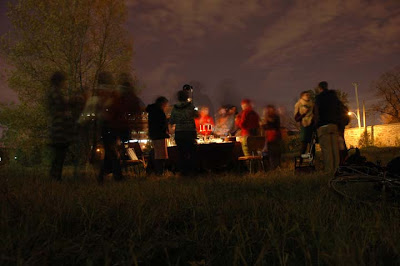photo Nicole Fournier
photo Nicole Fournier
photo Karen Spencer
photo Karen Spencer
photo Nicole Fournier
photo Karen Spencer
photo Nicole Fournier

LIVE DINING at Artivistic2007
photo Alfonso Arzapalo
LIVE DINING at Artivistic2007
photo Alfonso Arzapalo
photo Nicole Fournier
photo Nicole Fournier
photo Alfonso Arzapalo
photo Nicole Fournier
LIVE DINING at Artivistic, lived its collective spirit at night, with preparing, cooking and dining. Participants desired to be mainly observers, some joined in, in the preperation, and many enjoyed eating, with foraged burdock in the soup and stir-fry, and red clover in the salad, and simply being together dining in the outdoor context. Foraging or guerilla foraging and planting or guerilla gardening happened all in the same location, just before and near dusk, before most people arrived in the night.
Similar but still different to the Visualeyez contexts, where there was guerilla foraging in a parking lot and guerilla gardening on an unused for sale green space, for LIVE DINING, at Artivistic, the site is an undesignated wild plant, non-edible and edible plant growing site, where no one could say if it was public or private property. When I scouted out the location to do LIVE DINING for Artivistic, I met people walking their dogs, and saw people who use it as a shortcut or just where people pass by going from one place to another. Because of not knowing the level of contamination of the site, being right next to industry and close enough to train tracks, we only used a bit of foraged food, for symbolic purposes. Burdock does grow quite abunduntly on the site, but the particular root I used was foraged from a site I knew is not contaminated. The rest of the veggies did come from store, and from the perrennials I planted, that came from my own backyard edible garden, or as I like to call it "polyculture agriculture" space.
HARVEST FEST images (see below): LIVE DINING at the roof top garden Harvest Festival, at McGill University's downtown campus in Montreal (Quebec, Canada). McGill was the main Roof Top Garden site this year for the Roof Top Garden Project (a partnership between Alternatives and Santropol Roulant) that provides the veggies, herbs and flowers for Santropol Roulant's kitchen, which is the place where the wonderful volunteers and staff make meals for people who have lost autonomy in society.
all photos below by Nicole Fournier
LIVE DINING began at about 6pm... where the public were at first not sure how to participate, and were also wonderfully surprised when they were invited to harvest and cook and eat for free. And then.....
...by dusk and nightfall, around 8pm to 9:30pm, LIVE DINING took on a life of its own, as small groups came around to harvest and cook themselves up a meal. See images below
The Harvest Fest garden seen in the pictures above is all in growers or containers, the special roof top garden containers designed for the roof top garden project* LIVE DINING took place amidst the growers containing all the food. The care and maintenance that went into the growing of the edible garden, from May to October 2007, goes to all the volunteers and those responsible for the Roof Top Garden Project, who work for Alternatives and Santropol Roulant.
LIVE DINING at the Harvest Fest, was a way to help connect the public to urban agriculture, through the Roof Top Garden Project and their method of soil-less grower designs, as a method for people to grow their own food and contribute to their own food security and greening of cities (critical for helping cool down the planet). People were invited to harvest, prepare and cook the harvests from the growers. In the context of the Harvest Fest, this opening up to the public to share in the harvests, to share in the work (care) that all Roof Top Gardeners put into the Project of growing food, shows this collective giving and sharing for free (no monetary cost) to all who came to the Harvest Festival. This involvement, through the LIVE DINING project, to participate in harvesting, cooking and dining for free, became a wonderful collaboration connected to the work of the Roof Top Garden Team, who planted and cared for the garden, and reflects key elements to the LIVE DINING site specific, adaptable concept of non-monetary exchange, creating a sense of community, small scale food production and a new element that i see fitting in the LIVE DINING concept of self-organization.
*To note: The growers are "innovative soil-less grower designs. The Rooftop Garden Project has developed many beautiful growers that are simple to use and build, and can be constructed entirely from recycled materials! Soil-less gardening is an exciting new way to green small urban spaces such as rooftops, balconies and terraces. The gardens are extremely efficient, requiring much less water used by conventional gardens, and can be significantly more productive in the same space. Soil-less gardening is not new; it is based on hydroponics, which refers to systems where plants are fed only by nutrients dissolved in water. Our methods combine hydroponics with organic gardening and permaculture principals to create simple to use and affordable gardens which rely solely on human energy."
This quoted information is taken directly from the Roof Top Garden Project website

